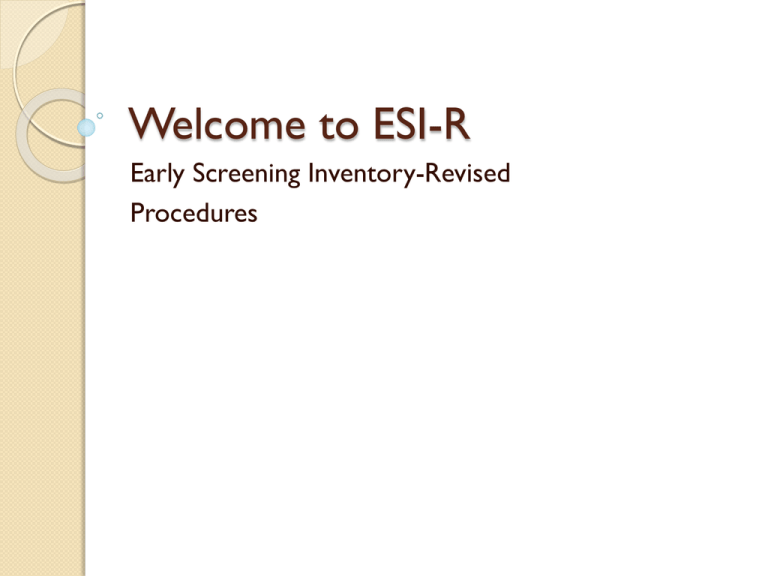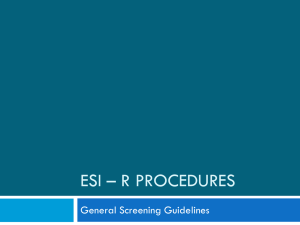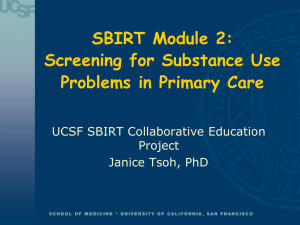ESI-R Procedures
advertisement

Welcome to ESI-R Early Screening Inventory-Revised Procedures ESI-R Early Screening Inventory- Revised ◦ This screening tool has been adopted by the WMISD Early Childhood Leadership Team to meet the requirements of the GSRP and Head Start Legislation for a common screening tool. ◦ It is to be used by all preschools in the WMISD area. Local Superintendents, NEMCSA and NMCAA have approved this tool. Developmental Screening Developmental Screening is intended to identify those children who have a high probability of exhibiting delayed or abnormal development. Preschool screening is intended to identify children who are at high risk for school failure. Screening is done at a particular point in time. Misuses and Abuses of Screening School entrance and readiness test Diagnosis IQ tests Labeling children Insensitivity to bilingualism and cultural differences Isolations from follow-up evaluation and intervention Early Screening Inventory Valid and Reliable ESI is valid and was standardized with 6,000 children. It is a norm-referenced screener ESI’s reliability was based on giving this screener to the same group of children by 3 different testers. Screening vs. Assessment ESI – R is a screening tool Screening tools are used to identify children that may need further assessment to determine if they are at risk for school failure. It is NOT used to determine a disability; more in-depth assessment tools would be used for that purpose. It is NOT a progress monitoring tool; the Gold and other tools will be used to measure progress over time. Ordering Information Protocols can be ordered from Pearson, Inc. ◦ ◦ ◦ ◦ ESI-R Preschool (ages 3:0-4:5) ESI –R Kindergarten (ages 4:6-5:11) Parent Questionnaire (optional) Need to have both protocols available since children may enter preschool already over 4:5 www.pearsonassessments.com 1-800-627-7571 ◦ Please be sure to have a manual to which to refer as you prepare to screen your students. Applications ESI-R is designed to identify children who may need further evaluation to determine if they have a condition that may place them at risk for school failure. It should be used only to identify the possibility of a learning or handicapping condition that might affect a child’s overall potential for success in school. Applications, cont. ESI-R is a screening tool, not a readiness test Screening tools are meant to be predictive; they look at the ability or potential to acquire skills They look at skills children have actually acquired Applications, cont. High stakes decisions should not be made as the result of screening Readiness test focus on the skills Determining a Child’s Current Age Enter date of screening Enter Date of Birth use the online chronological age calculator from Pearson at http://ags.pearsonassessments.com/calc/calc1.asp Tips for manual computing Borrow for days◦ Reduce the month column by 1 ◦ Add 30 to the days column Borrow for month ◦ Reduce the year by 1 ◦ Add 12 to the months Rounding a Child’s Age If the number of days in the current age is 16 days or up, round the month up to the next higher month If the rounded age is between 3:0-4:5 use the ESI- R Preschool If the rounded age is between 4:6 -5:11 use the ESI-R Kindergarten After Completing the ESI-R ◦ After completing the ESI-R for each student, the results are to be sent in a class composite chart to the WMISD Early Childhood Special Education Office at: 231-876- 2307 (Fax) rboonzaaijer@wmisd.org (email) To email the results in the excel spreadsheet, please save the file as your class and the year. Then open a new email and attach the excel spreadsheet of your ESI-R class composite scores. Be sure to save a copy for yourself. Using ESI-R Class Composite Look at the data If there is a group of students who need to acquire a certain skill: ◦ Develop large group activities to increase their skill and competence in that area. ◦ Develop small group activities targeted to the area where they show a specific need. ◦ Assess them with “digging deeper” assessment tools like MLPP, PALS, PPVT, etc. ◦ Use the WMISD Preschool Teacher Toolbox ◦ WMISD Preschool Teacher Toolbox WMISD Procedures for Results ◦ What to do if a child falls into the Rescreen/Refer Category Re-Screen in 8-10 weeks Collect information from parents and health care providers ESI Parent Questionnaire Health Screening Information Observe children with Gold objectives in mind and take anecdotal notes Procedures, cont. Assess children with more specific assessments like the PPVT, PALS, MLPP, etc. Collect data regarding specific concerns Behavior tracking, work samples, video Contact building therapists or preschool consultant to discuss immediate concerns Procedures, cont. • What if they are rescreened and still fall into the rescreen/refer categories? ◦ Follow the Next-Steps procedures in your Recognition and Response notebooks ◦ Reminder: professional judgment supersedes protocol Developed by: Liz Walker, WMISD Early Childhood Specialist Ruth Boonzaaijer, WMISD Early Childhood Special Education Teacher Consultant Questions? Email us at: lwalker@wmisd.org rboonzaaijer@wmisd.org







